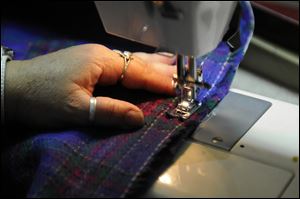
Sewing catches a new wave of fans
3/11/2012
Aida Acosta, of Hartford, Connecticut, uses a sewing machine to work on a cape she is making.
HARTFORD, Conn. -- When Aida Acosta first heard the growl of the machines, it scared her. But within a few months, the once-ominous whir had turned a length of flannel into a robe and three yards of blue houndstooth check into a stylish jacket for her sister.
She was now friends with her sewing machine.
Under the tutelage of Margrete Olsen, a professional seamstress, Ms. Acosta and other class members at Loaves and Fishes Ministries, a Hartford, Conn., nonprofit group which offers services for services for families in need, have learned to stitch a seam, install a zipper, read a paper pattern, and make alterations.
A wide range of fabrics, including ethnic prints, and easy-to-apply underpinnings, such as iron-on interfacing (the stuff that makes a collar or placket hang just right) along with the availability of sewing machines for every budget has made sewing more accessible than ever. Visions of making a quilt for baby, hoodies for the twins, or even a one-of-a kind creation that might wow Heidi Klum of Project Runway, have spurred many consumers to try their hand at sewing.
"Jo-Ann Fabrics and Crafts has boosted its class offerings," said Courtney Talkington, the company's manager of education. "Sewing classes are our most popular offerings. To accommodate the growing popularity, we offer a variety of classes at various skill levels, from basic skills to more involved pattern-based classes. We have seen double-digit increases of enrollment in our sewing classes, primarily in the Sewing 101 classes," Ms. Talkington said.
"We're hearing from younger sewers -- young old, male, female," said Deana Tierney May, editor of Threads magazine, published by Taunton Press in Newtown, Conn.
Threadsmagazine.com had its highest traffic month in January with more than 1 million page views. Traffic at the site is up 28 percent as of January, year over year. To meet the increased demand from a new generation of sewers, Taunton recently launched a magazine aimed at younger sewers and beginning sewers called SewStylish (www.besewstylish.com).
Two years ago, Threads launched the Teach Yourself to Sew DVD series. The series' second season came out last fall and season three debuts this fall, Ms. May said.
Project Runway, the popular Lifetime television show, has sparked renewed interest in sewing, Ms. May said. "Making your own clothes wasn't a cool thing to do for a while," she added. "When Project Runway appeared, it opened up people's eyes to possibilities."
Knowing how to hem a skirt or a pair of jeans also can save on tailoring costs.
"Mass market and off-the-rack clothing is made to one body type and height," said Ms. May. "Everybody has variations and fitting is a big factor."
Sewing your own allows you to craft a quality garment that fits fabulously, May says.
Sewing machines, including the familiar Singer and Brother brands, are available at discount stores and discount clubs for $100 or less. More elaborate sewing machines with 150 types of stitches or more, including quilting and embroidery, typically sell for $300 or more.
There's just one hitch: Once you buy a machine, you have to take it out of the box.
"Some of the women I teach bought their machine 10 years ago and have never taken it out of the box," said Nightwing Whitehead, who teaches beginning-sewing courses through West Hartford Continuing Education program. Ms. Whitehead requires students to bring their sewing machine to class; the rest of the session is usually spent learning how to thread it.
Ms. Olsen, who also teaches sewing classes through the continuing education program, said 90 percent of problems experienced by beginning sewers is because "they haven't threaded the machine right." Master that and you've eliminated a major roadblock.
And here's the other secret: Learning to sew doesn't have to be painful. You can learn as much or as little as you choose. Whether you simply want to learn to hem a pair of jeans, make pillows, copy couture dresses, or get a job providing full-service alterations for stores, there's a sewing group or class to match your aspirations, Ms. Olsen said.
"I had one man who just wanted to make a pair of Madras pants to go to Florida," said Ms. Olsen. "Another man wanted to be able to hem his jeans -- once he learned that, he stopped coming to class."
Ms. Acosta, who started sewing just three months ago, is tackling her third project, a hooded cape in a blue woven plaid. Family members are thrilled.
"My mom says now she can buy any pants pattern and I can sew it," Ms. Acosta says.
Here's what you need to know to become a sewing star:
Classes
Check the schedule at your local Jo-Ann Fabric and Craft Stores, many of which offer Basic Sewing or instruction in simple garment construction or quilting. For listings, go to www.joann.com select store locator and check the "classes" box. Or check out courses through continuing education programs.
Visit Threads magazine at www.threadsmagazine.com.
Groups
The American Sewing Guild, a nonprofit group which has 25,000 members nationwide, sponsors neighborhood groups that typically meet once a month. Meetings are open to everyone, free, and it's not necessary to join to attend. To find a group, go to www.asg.org.
Sewing machines
Good machines start at about $300. While you can pick up a $70 machine at many discount stores, the difference in the quality of the parts and the quality of the stitch is considerable, said Ms. Olsen. If you're on a budget, but want a good quality machine, consider buying a used machine.
Just For Fun:
Want to try your hand at making a dress form using duct tape? Go to: http://bit.ly/AdjD5r